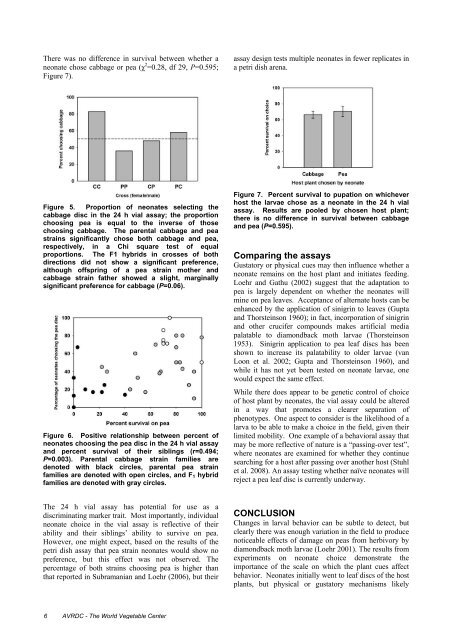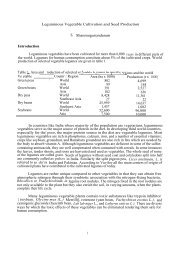Management of the Diamondback Moth and Other Crucifer Insect ...
Management of the Diamondback Moth and Other Crucifer Insect ...
Management of the Diamondback Moth and Other Crucifer Insect ...
Create successful ePaper yourself
Turn your PDF publications into a flip-book with our unique Google optimized e-Paper software.
There was no difference in survival between whe<strong>the</strong>r aneonate chose cabbage or pea (χ 2 =0.28, df 29, P=0.595;Figure 7).assay design tests multiple neonates in fewer replicates ina petri dish arena.Figure 5. Proportion <strong>of</strong> neonates selecting <strong>the</strong>cabbage disc in <strong>the</strong> 24 h vial assay; <strong>the</strong> proportionchoosing pea is equal to <strong>the</strong> inverse <strong>of</strong> thosechoosing cabbage. The parental cabbage <strong>and</strong> peastrains significantly chose both cabbage <strong>and</strong> pea,respectively, in a Chi square test <strong>of</strong> equalproportions. The F1 hybrids in crosses <strong>of</strong> bothdirections did not show a significant preference,although <strong>of</strong>fspring <strong>of</strong> a pea strain mo<strong>the</strong>r <strong>and</strong>cabbage strain fa<strong>the</strong>r showed a slight, marginallysignificant preference for cabbage (P=0.06).Figure 6. Positive relationship between percent <strong>of</strong>neonates choosing <strong>the</strong> pea disc in <strong>the</strong> 24 h vial assay<strong>and</strong> percent survival <strong>of</strong> <strong>the</strong>ir siblings (r=0.494;P=0.003). Parental cabbage strain families aredenoted with black circles, parental pea strainfamilies are denoted with open circles, <strong>and</strong> F 1 hybridfamilies are denoted with gray circles.Figure 7. Percent survival to pupation on whicheverhost <strong>the</strong> larvae chose as a neonate in <strong>the</strong> 24 h vialassay. Results are pooled by chosen host plant;<strong>the</strong>re is no difference in survival between cabbage<strong>and</strong> pea (P=0.595).Comparing <strong>the</strong> assaysGustatory or physical cues may <strong>the</strong>n influence whe<strong>the</strong>r aneonate remains on <strong>the</strong> host plant <strong>and</strong> initiates feeding.Loehr <strong>and</strong> Gathu (2002) suggest that <strong>the</strong> adaptation topea is largely dependent on whe<strong>the</strong>r <strong>the</strong> neonates willmine on pea leaves. Acceptance <strong>of</strong> alternate hosts can beenhanced by <strong>the</strong> application <strong>of</strong> sinigrin to leaves (Gupta<strong>and</strong> Thorsteinson 1960); in fact, incorporation <strong>of</strong> sinigrin<strong>and</strong> o<strong>the</strong>r crucifer compounds makes artificial mediapalatable to diamondback moth larvae (Thorsteinson1953). Sinigrin application to pea leaf discs has beenshown to increase its palatability to older larvae (vanLoon et al. 2002; Gupta <strong>and</strong> Thorsteinson 1960), <strong>and</strong>while it has not yet been tested on neonate larvae, onewould expect <strong>the</strong> same effect.While <strong>the</strong>re does appear to be genetic control <strong>of</strong> choice<strong>of</strong> host plant by neonates, <strong>the</strong> vial assay could be alteredin a way that promotes a clearer separation <strong>of</strong>phenotypes. One aspect to consider is <strong>the</strong> likelihood <strong>of</strong> alarva to be able to make a choice in <strong>the</strong> field, given <strong>the</strong>irlimited mobility. One example <strong>of</strong> a behavioral assay thatmay be more reflective <strong>of</strong> nature is a “passing-over test”,where neonates are examined for whe<strong>the</strong>r <strong>the</strong>y continuesearching for a host after passing over ano<strong>the</strong>r host (Stuhlet al. 2008). An assay testing whe<strong>the</strong>r naïve neonates willreject a pea leaf disc is currently underway.The 24 h vial assay has potential for use as adiscriminating marker trait. Most importantly, individualneonate choice in <strong>the</strong> vial assay is reflective <strong>of</strong> <strong>the</strong>irability <strong>and</strong> <strong>the</strong>ir siblings’ ability to survive on pea.However, one might expect, based on <strong>the</strong> results <strong>of</strong> <strong>the</strong>petri dish assay that pea strain neonates would show nopreference, but this effect was not observed. Thepercentage <strong>of</strong> both strains choosing pea is higher thanthat reported in Subramanian <strong>and</strong> Loehr (2006), but <strong>the</strong>irCONCLUSIONChanges in larval behavior can be subtle to detect, butclearly <strong>the</strong>re was enough variation in <strong>the</strong> field to producenoticeable effects <strong>of</strong> damage on peas from herbivory bydiamondback moth larvae (Loehr 2001). The results fromexperiments on neonate choice demonstrate <strong>the</strong>importance <strong>of</strong> <strong>the</strong> scale on which <strong>the</strong> plant cues affectbehavior. Neonates initially went to leaf discs <strong>of</strong> <strong>the</strong> hostplants, but physical or gustatory mechanisms likely6 AVRDC - The World Vegetable Center
















